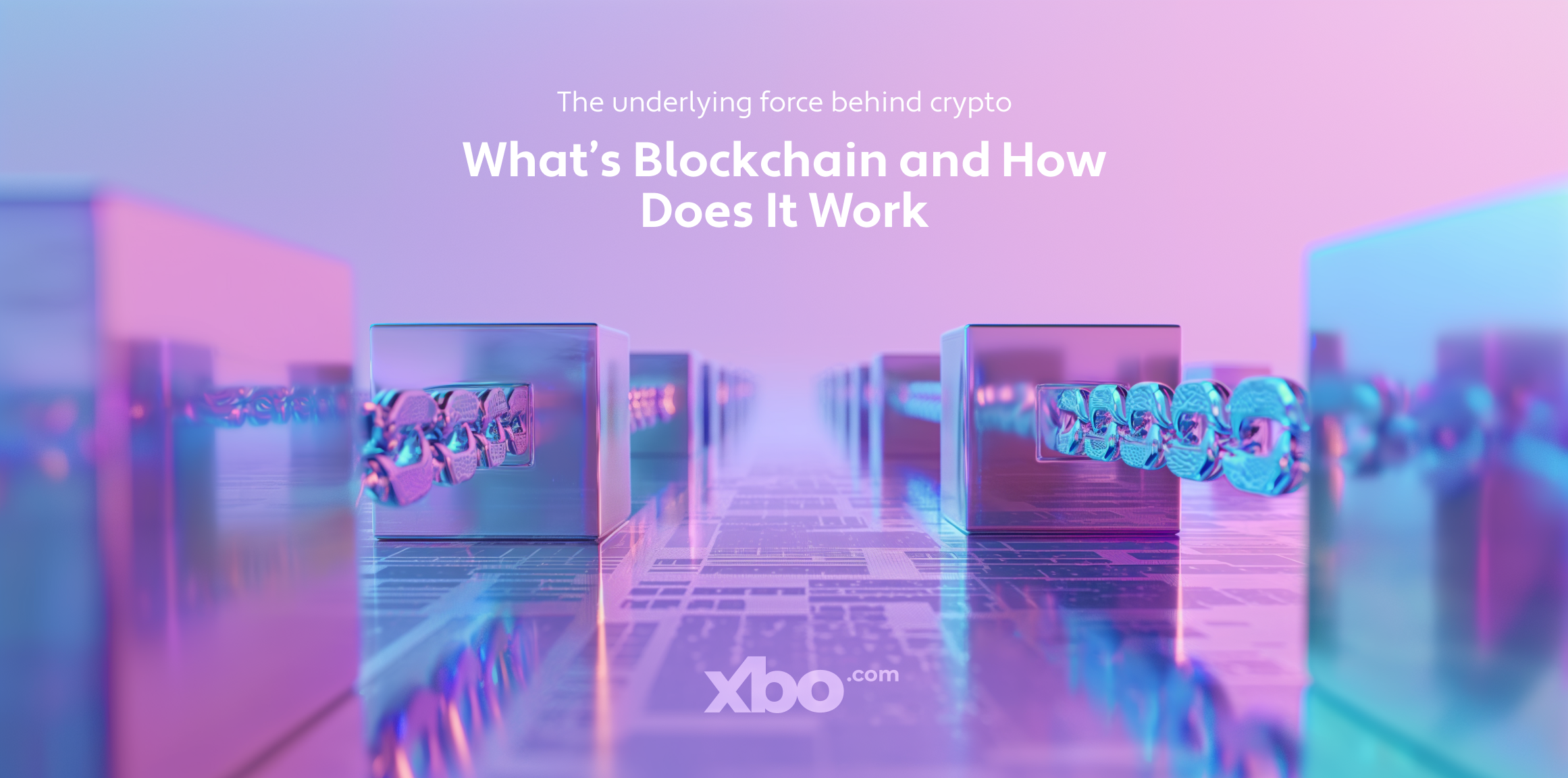The Underlying Force Behind Crypto: What’s Blockchain and How Does It Work

About 15 years ago, Bitcoin, the first cryptocurrency, was introduced to the world, disrupting traditional financial systems and challenging the way people exchange value. This groundbreaking event that gave rise to an actual technological revolution would’ve been impossible without blockchain, a technology often touted as the underlying force behind the crypto world. Today, this technology is known all over the world; however, knowing about a concept does not always mean understanding it correctly.
Blockchain 101: Exploring the Core of Cryptocurrency
So, what exactly is blockchain, and why is it more than just a buzzword? In this article, we'll try to find an extensive, yet simple answer to this question. Whether you're a seasoned crypto enthusiast or just stepping into the realm of digital assets, understanding blockchain is key to navigating this transformative landscape with confidence and insight.
Let’s jump into it.
What is blockchain?
The official definition could be formulated as follows: blockchain is a digital form of a distributed ledger that records and stores crypto transactions in a transparent and tamper-resistant manner. Sounds good, right? But what does this actually mean?
First things first, the word “ledger” essentially stands for a record-keeping system that tracks and stores information about something. For instance, accountants used to have bookkeeping ledgers in which they made records of their clients’ financial dealings. When talking about a digital ledger, the principles are essentially the same, but the information is recorded and stored electronically.
With this in mind, you can think of a blockchain as a digital distributed ledger that is not owned or controlled by a single entity, providing its decentralization. Instead, it operates on a network of computers, known as nodes, spread across the globe, utilizing the principles of cryptography. Each transaction happening within this system is recorded into a "block" and added to a chain of previous blocks, forming a chronological and unalterable record of transactions. That’s where the name comes from: a blockchain is literally a chain of consecutive blocks with information about specific crypto transactions and smart contract execution encrypted into them.
Defining features of blockchain
Here’s some crucial features of the blockchain technology that make it so special and noteworthy:
- Decentralization: Blockchains are typically decentralized, operating on a network of computers rather than relying on any central authorities, which makes blockchain technology an example of a trustless system. This allows for a distributed decision-making, removing the need for intermediaries.
- Cryptographic hashing: Blockchain uses cryptographic algorithms and hash functions to ensure the integrity and security of data. Using cryptographic keys, transactions and blocks of information are transformed into unique hashes, which are fixed-size, cryptographic representations of the original data. This enables secure storage and verification of data, making it difficult to alter information within the blockchain.
- Transparency: Blockchain provides a transparent and publicly verifiable record of transactions. Once a transaction is added to the blockchain, it becomes visible to all participants in the network. This transparency helps establish trust among users and prevents fraudulent activities.
- Immutability: Once data is added to a blockchain, it becomes extremely difficult to alter or delete, making the whole system virtually immutable. Each block in the blockchain contains a reference to the previous block, creating a chain of linked information. Any change made to a previous block would require altering subsequent blocks, making it practically impossible to tamper with the existing data without the consensus of the whole network.
How does blockchain work?
Now that we have a basic understanding of blockchain, let's dive deeper into how it actually operates. At the core of blockchain are its building blocks which house and preserve the records of transactions.
When someone initiates a transaction on the blockchain, whether it's transferring digital assets or recording another type of interaction, that transaction is grouped with others into a block.
Adding a new block to the chain involves a process called consensus, which indicates that all participants in the network agree on the validity of the block. There are various consensus mechanisms employed in different blockchain systems, two of the most popular being Proof-of-Work (PoW) and Proof-of-Stake (PoS).
- In a Proof-of-Work consensus mechanism, transaction validation occurs through the process of mining, with validators known as miners. They compete to solve complex mathematical puzzles, requiring substantial computational power and energy consumption. The miner who successfully solves the puzzle first gets the opportunity to add the new block to the chain and receives a reward. This process, while resource-intensive, provides security to the network as it becomes increasingly difficult for malicious actors to manipulate the blockchain.
- In a Proof-of-Stake consensus mechanism, instead of miners, validators are chosen based on the number of coins they hold and are willing to "stake" as collateral. The higher the stake, the higher the chances of being selected to validate transactions and add a new block to the chain. This mechanism consumes significantly less energy than Proof-of-Work, making it an attractive alternative.
Regardless of the consensus mechanism used, once a new block is added to the blockchain, it becomes an indelible part of the historical record. As soon as a transaction is verified and added to the chain using public and private key cryptography, it is incredibly challenging to alter or delete. The immutable and transparent nature of the blockchain ensures accountability and enhances trust among participants. Any user’s ability to inspect the entire transaction history provides transparency and eliminates the need for any intermediaries, making blockchain a unique, fully independent system capable of revolutionizing various spheres of people’s lives, from financial transactions to supply chain management.
The Takeaway
Blockchain is the underlying force behind the cryptocurrency revolution, providing a decentralized, secure, and transparent system for recording and storing transactions. By utilizing cryptographic hashing and consensus mechanisms, blockchain ensures the integrity and immutability of data. Its decentralized nature eliminates the need for intermediaries, enabling peer-to-peer transactions and reducing costs.
Understanding blockchain is crucial for navigating the world of cryptocurrencies and realizing its broader implications. With its revolutionary features and transformative capabilities, blockchain stands as a technological milestone that is difficult to overestimate. So, every time you buy crypto on XBO.com, remember that you’re reaping the benefits of an innovative technology that has the power to reshape our digital future!
Disclaimer: Our content does not constitute financial advice. It is only intended for informational and educational purposes.








